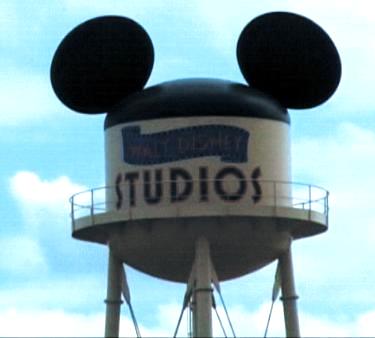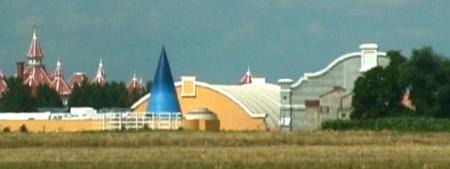A First Look at the Walt Disney Studios Paris
Page 1 of 6

Despite the Disneyland Paris (“DLP”) Resort covering a huge area, the EuroDisney managers and Walt Disney Imagineering (“WDI”) decided on a site adjacent to the Disneyland park to build the Walt Disney Studios Paris. This makes the park within walking distance of the TGV (high speed train) and RER (subway) networks, the main car park and the Disney Village complex. The beautifully landscaped Fantasia Gardens in front of the Disneyland Hotel which serves as the entry plaza for the Disneyland park are being extended westwards to reach the main gates to the Studios. Although both parks sit side-by-side, the Studios is barely visible from inside Disneyland. A recent visit demonstrated that even the Earffel Tower is only visible from certain locations within the park. The tallest building is the soundstage that encloses the Rock ‘n’ Roller Coaster and this is located in the furthest south tract of land in the Studios and is invisible to the Disneyland park guest.
Let us begin, with a fairy story. Once upon a time, there was a global entertainment behemoth that could do no wrong. After a rocky period in the early eighties, a new team invigorated the sleeping giant into action with new investment in its stagnant theme park division and slumbering entertainment team. Suddenly, new company owned and operated hotels sprang up and new attractions and whole new theme parks worked their way from the drawing board to reality after years of stuttering performance due to lack of investment. During this period of expansion, the management team signed an agreement with the French authorities that they thought was a guaranteed success with virtually all the capital expenditure in infrastructure being borne by the government. They promised a new subway extension, highway exits and gleaming new high-speed rail links. The management team must have been chuckling to themselves and as pleased as punch to have secured such a lucrative agreement. The French too must have believed that they had attracted a huge player in the world of theme parks that would bring much needed permanent jobs and tourists with hard cold cash to spend in France. They had convincingly beaten Spain and England to the deal with their promises of investment.

The Studios from a Distance
The year was 1987. The fanfare at the unveiling of the plans to build a new EuroDisneyland complex with a Magic Kingdom, six new Disney hotels, a golf course, an entertainment and retail village and a campground was grand and optimistic. Eisner and Wells even spoke of their plans for a second theme park to open in 1997 to mark the five year anniversary of EDL. We were all in awe of the size of the project’s first phase. Nearly 5,000 hotel rooms and a fully functioning Magic Kingdom with virtually every E-ticket ride in place including It’s A Small World, Pirates of the Carribean, a Haunted Mansion (to be called Phantom Manor) and Big Thunder Mountain Railroad. Each ride was to be bigger and more elaborate - particularly in the outdoor theming - than ever before. The park delivered on all aspects, except one. The complex had the misfortune of opening at the height of a recession on April 12, 1992. I was present on opening day, and the crowds were as light as those for Disney’s California Adventure this past February. Although the park beat expectations in that inaugural year, the park had a significant loss. This was due to the fact that tourists could not afford the pricey EDL hotels (the cheapest resort, the Hotel Santa Fe charged nearly $100 per room per night off-season, a considerable amount of money in 1992 for a basic hotel with few amenities) and their spending inside the park was significantly lower than their US counterparts. Guests brought packed lunches and did not buy souvenirs. The majority of guests bought little else than their entrance passes.
The management team had bargained and planned for much higher turnover and it was evident from the first year that a restructuring was necessary. As a shareholder I was quickly horrified to see my investment plunge from a high of £16.49 (after an issue price of £7.07) to a low of just 48p. However, the park’s finances were restructured and new shareholders brought in to stabilise the company and reduce the Walt Disney Company’s shareholding to just 39%. The park changed its name to Disneyland Paris, although the owning company remained EuroDisney. The attendance figures peaked at 12.6 million guests in 1997 during the “It’s the Year To Be Here” celebrations for the complex’s fifth birthday. Those figures were buoyed by the three other critical financial indicators, namely "spend per guest," "occupancy rate" and "spend per room" that have increased ahead of inflation every year, and for every quarter, even during the harsh cold winters that had initially punished the park with dismal attendance figures. The park introduced major new shows and parades rather than E-ticket attractions, which were cheaper to develop and maintain, except for the $100 investment in Space Mountain. The seasonality was combated with Halloween festivities and a Christmas season that has become a big hit. Annual passholder numbers are at their peak and increasing at a higher rate than at any time in the park’s history.
